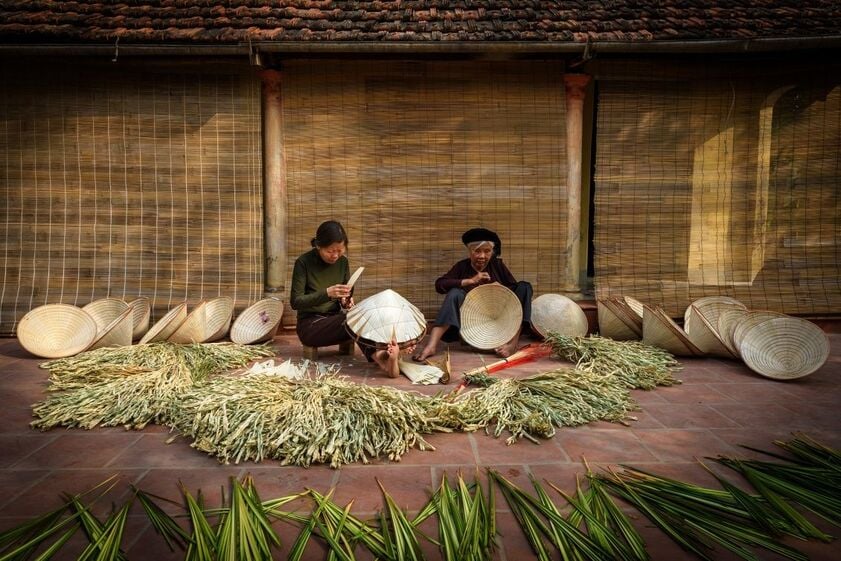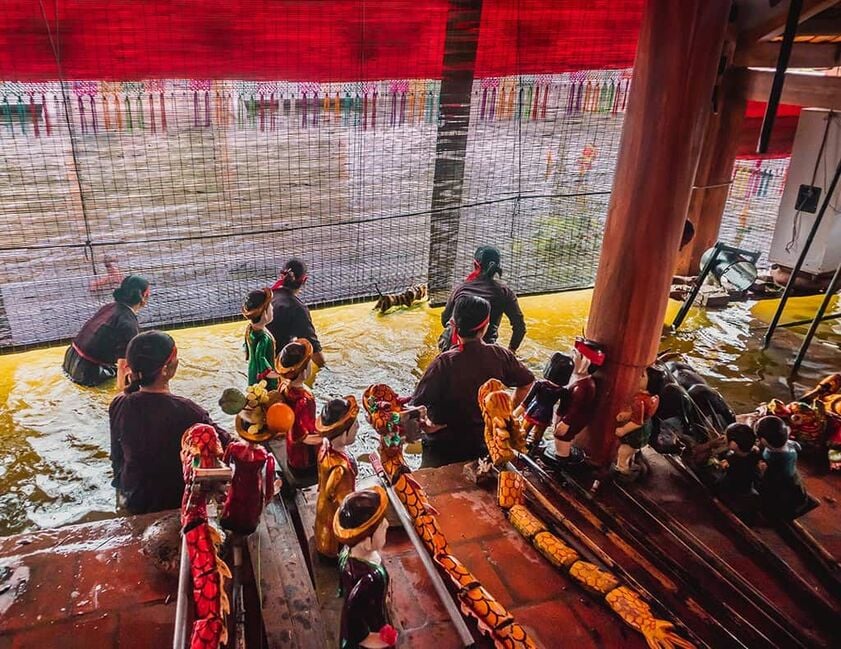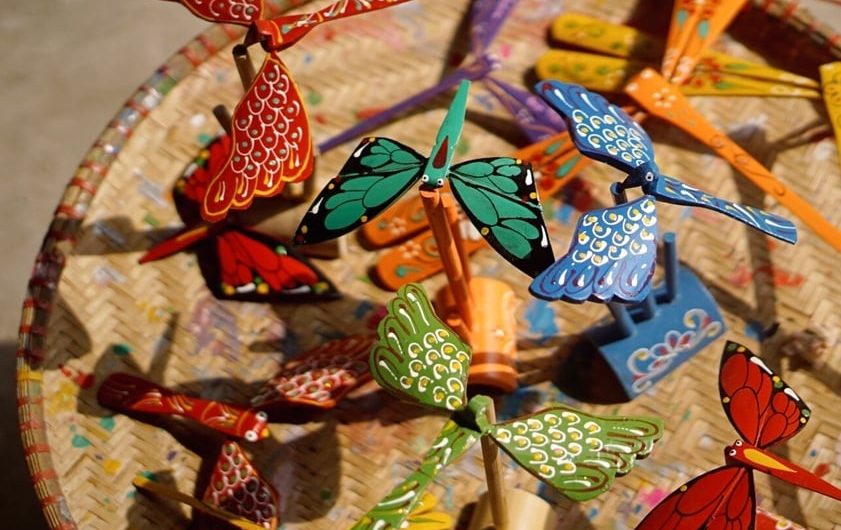The thousand-year-old cultural capital of Hanoi carries immense historical and cultural values closely linked to the formation and development of the nation of Vietnam. Among its renowned historical and cultural landmarks are the Temple of Literature, Hoan Kiem Lake, Ngoc Son Temple, Hanoi’s 36 Old Streets, Thang Long Imperial Citadel, and Hoa Lo Prison.
DanangPrivateCar.com’s will take tourists to all these famous tourist spots. However, if you have visited Hanoi for sightseeing and are still curious about the life of the native Hanoians, interested in the daily activities, and the handicraft villages that contribute to the image of Hanoi’s 36 Old Streets, with names like Hang Be, Hang Dao, Hang Gai, Hang Ma, Hang Quat, then exploring the traditional famous craft villages in Hanoi will once again allow you to delve deeper into the thousand-year-old cultural history of ancient Vietnam.
Table of Contents
Top Famous Craft Villages in Hanoi
Thach Xa Bamboo Dragonfly-Making Village
- Location: Approximately 25 km from Hanoi, situated at the foot of Tay Phuong Mountain in Thach Xa commune, Thach That district, Hanoi
- Transportation: From Hanoi, travelers can go to Gia Lam Bus Station or Giap Bat Bus Station and take a bus to Yen Nghia Bus Station. Then, continue with another bus to Son Tay, asking the driver to stop near Tay Phuong Pagoda. From the main road, it’s a 500m walk along the village road to reach the destination. Additionally, if you wish to find a fast and convenient means of transportation with door-to-door service, you can book a private car service with a driver in Hanoi through DanangPrivateCar.com.
Bamboo has long been a symbol of the northern countryside in Vietnam. The bamboo hedge not only serves as a boundary defining the village’s territory but also holds memories of childhood for those who grew up in these villages away from the city.
From the simple houses of Thach Xa commune, Thach That district, Hanoi, traditional artisans with skilled hands, diligence, and creativity have crafted unique bamboo dragonflies that can perch anywhere due to the principle of gravitational balance.

When scientists study dragonflies, they refer to them as “aerial assassins” or “stealth fighters” to emphasize the differences and extraordinary abilities of these insects. This inspiration has led humans to create new technologies based on the incredible flying skills and 360-degree vision of dragonflies. Conservation areas for dragonflies exist worldwide to express gratitude for the benefits dragonflies bring to humanity.
The folk artisans of Phung Xa have created dragonflies from bamboo, simple yet familiar. Most notably, these dragonflies have the remarkable ability to maintain balance on any terrain and material.
The perseverance and meticulousness of these artisans breathe life into the dragonflies, imparting true sensory and spiritual values.
These brightly colored bamboo dragonflies have become popular souvenirs and decorations for many tourists. The cost of purchasing one is very affordable, ranging from 3,000 to 10,000 VND per dragonfly. Additionally, there are other unique bamboo products crafted by artisans in the village, such as bamboo butterflies, bamboo lamps, and decorative lights.
Quang Phu Cau Incense Craft Village
Located approximately 30 km from the center of Hanoi, in Quang Phu Cau commune, Ung Hoa district, Hanoi, this craft village has a history of nearly 100 years. Initially, the incense-making craft was concentrated mainly in Phu Luong Thuong village, but in recent years, this traditional craft has expanded to other villages within the commune, such as Cau Bau and Dao Tu.
As travelers stroll along the roads in the Quang Phu Cau region, about 30km from the center of Hanoi, they are sure to be surprised by the predominant red and brown colors—the colors of incense sticks and their stems. The meticulous and clean stages of incense production reflect the spiritual significance attributed to this craft by the local people, who are particularly careful throughout the process.

Starting from basic steps like splitting bamboo (or using bamboo tubes), shaping the sticks, dyeing the tips, forming the stems, drying, and packaging, the artisans invest a great deal of effort. The stage of classifying the incense sticks and arranging them for dyeing the tips is especially crucial in the incense-making process.
While this industry used to rely mainly on manual labor, modern times have seen the introduction of machinery, making the incense-making process more straightforward. The entire village is bathed in a vibrant red color. What sets Quang Phu Cau incense apart from other places is its avoidance of chemical additives, making it exceptionally safe for health.
Renowned Hand Embroidery Craft Village in Hanoi – Quat Dong
- Address: Quat Dong Commune, Thuong Tin District, Hanoi
In its early days, the craft village of Quat Dong primarily focused on renting out couplets, banners, etc., used for hanging in communal houses and pagodas, as well as for embroidering towels and court costumes. Over time, the craft village diversified its products to include various items such as embroidered paintings, cushions, and clothing. The embroidered works here are meticulously crafted by skilled artisans, carrying profound meanings. As a result, the embroidered products from the craft village in Hanoi – Quat Dong, have successfully been exported to more than 20 countries, including the United Kingdom, France, Thailand, Japan, South Korea, and others.

Bat Trang Ceramic Village
The name Bat Trang originated during the Le dynasty, representing the integration of five famous pottery lineages from the Bo Bat region in Thanh land with the Nguyen lineage in Minh Trang territory. The five major lineages, including Tran, Vuong, Nguyen, Le, and Pham, gathered and decided to send some artisans, pottery craftsmen, and their families to migrate towards the Thang Long capital to seek new opportunities. This marked the beginning of the traditional pottery craft in the Bat Trang area as it is known today.

How to get to Bat Trang Ceramic Village:
By Bus: From Long Bien Transfer Station, travelers can take bus number 47 directly to Bat Trang Ceramic Village, which takes approximately 1.5 hours.
Private Transportation: From the center of Hanoi, cross the Chuong Duong Bridge and turn right following the Red River dike. When you see the sign for Bat Trang Ceramic Village, turn in that direction.
What to explore in Bat Trang:
- Bat Trang Village Communal House: Located right next to the riverbank.
- Bat Trang Ceramic Market: Upon entering, visitors will encounter numerous larger-than-life ceramic vases, statues, and flower pots in various sizes and colors. By carefully browsing, one can find unique ceramic products at very reasonable prices. From bowls, cups, plates, miniature landscapes, bonsai pots to souvenirs and ceramic jewelry, the diversity is sure to captivate tourists.
- Pottery Making Experience: If you have young children in your family, experiencing pottery making in Bat Trang Village will help them better understand the traditional craftsmanship of our country. Many families in Bat Trang offer this service to visiting tourists. The host provides visitors with a large, slightly moist piece of clay and a potter’s wheel. The task for visitors is to freely shape the clay. For those skilled in handcraft, who knows, you might be an undiscovered artisan of the craft? The drying stage takes about 30 minutes, followed by the decorating and glossing stage to enhance the durability of the product over time.
- Visit the ancient house Van Van – top 10 most beautiful ancient houses in Vietnam: Located at the end of Bat Trang Village, it exhibits many ancient products of Bat Trang Village, such as dragon vases, blue enamel pots, and stamped ceramic molds. It serves as both a repository of ancient artifacts and a simulated workshop for pottery kilns.
Chang Son – Famous Fan Making Craft Village in Hanoi
- Address: Chang Son Commune, Thach That District, Hanoi
Chang Son Fan Village is a traditional craft village in Hanoi that has existed for hundreds of years. The fans produced here are of high quality, featuring unique shapes and eye-catching colors, made from various materials such as bamboo, fabric, silk, and paper.

Especially, the illustrations on each Chang Son fan represent famous landscapes or historical stories about national heroes. Through these artworks, the craftsmen aim to spread the cultural essence of Vietnam to all corners of the world.
Phu Vinh Village – Bamboo Weaving Craft Village in Hanoi
- Address: Go Dau, Phu Nghia Commune, Chuong My District, Hanoi
Phu Vinh bamboo weaving village is a renowned craft village in Hanoi, known for its traditional bamboo weaving, originating from the mid-17th century. Using familiar materials such as bamboo, rattan, and sedge, skilled artisans craft unique and impressive bamboo products.

You can encounter Phu Vinh bamboo weaving products everywhere in daily life, including trays, baskets, furniture, cabinets, and artworks.
Van Phuc Silk Village, Ha Dong
Known as Van Phuc Silk Village or Hanoi’s Silk Village, this village is situated along the banks of the Nhue River, in Van Phuc Ward, Ha Dong District, approximately 10 km from the center of Hanoi.
In the past, the village was named Van Bao, but under the Nguyen dynasty, due to a change in officials, it was renamed Van Phuc as it is known today. Van Phuc silk was once the chosen fabric for royal costumes during the Nguyen dynasty and gained significant popularity. From King Khai Dinh to King Bao Dai, all were genuine enthusiasts of this high-quality fabric. Some historical documents and records suggest that this region was established in the year 865 AD, indicating that the silk-weaving craft has existed for over a millennium.

In the early 20th century, Van Phuc silk was introduced to the international market at the 1931 Marseille Fair in France and the 1932 Paris Fair. Since then, the French have praised this as an exquisite product of Indochina, and the silk was exported to many Eastern European countries on an international scale.
Currently, the village has over 1,000 weaving frames with nearly 800 households engaged in the silk trade, accounting for 60% of the total households residing there.
The ancient silk village is adorned with ancient banyan trees, wells, and communal yards, maintaining long-standing cultural traditions. Visitors can clearly sense the traditional village atmosphere of Vietnam when they come to Van Phuc. Despite the ups and downs of time, Van Phuc silk still preserves its sophisticated, clever, and aesthetically rich features, embodying the elegance of a traditional craft village.
Conical Hat Village – Chuong My
Nestled beside the Day River, the Conical Hat Village is situated in Phuong Trung Commune, Thanh Oai District, Hanoi. Renowned for making conical hats for over three centuries, these hats have become an integral part of the lives of Vietnamese women in rural areas. During market days, mothers and sisters bustlingly go to the market to sell unique handmade products near the Chuong Pagoda area. Buyers and sellers follow one another, carrying with them emotions and aspirations for a bountiful harvest. The rural market atmosphere makes visitors feel like they have stepped back in time to the countryside of yesteryears.

It’s not only the traditional conical hats that visitors can witness but also other hat variations such as conical hats with straps, coconut leaf hats, and palm leaf hats. There are likely no other places in Vietnam with such a diverse range of hats.
The image of Vietnamese women in traditional ao dai dresses adorned with conical hats has inspired countless poems and enamored those who love Vietnamese culture, both domestically and internationally. These simple and rustic conical hats conceal within them an entire art form.
Dao Thuc Village – Unique Water Puppetry Craft Village
- Address: Thuy Lam Commune, Dong Anh District, Hanoi
Water puppetry is a traditional folk art that has been present in Vietnam for about 300 years. If you want to enjoy interesting water puppet performances imbued with the historical and cultural essence of the country, then visit Dao Thuc water puppet village. The smooth and graceful folk dance movements, performed by skilled artisans, promise to leave you with unforgettable impressions.

Cage making village Canh Hoạch – Famous craft village in Hanoi, both domestically and internationally.
- Address: Canh Hoach Village, Dan Hoa Commune, Thanh Oai District, Hanoi
The bird cages from Canh Hoạch village are so renowned that even customers from abroad seek them out to purchase these traditionally famous cages. According to buyers, the bird cages from here are extremely durable, elegant, eye-catching, and come in a variety of sizes and styles. On average, Canh Hoạch bird cages range in price from 500,000 VND to 1,500,000 VND.
Here is a list of the top traditional craft villages in Hanoi that have existed for a long time. If you have the opportunity, at least once, you should visit these destinations to explore the traditional beauty deeply imbued with the cultural essence of the nation.


Comments